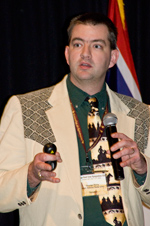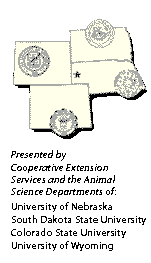Managing Heifers After AI
Nutrition following AI is critically important for heifers.
by Kindra Gordon for Angus Productions Inc.
CASPER, Wyo. (Dec. 1, 2009) — How heifers are managed after they are artificially inseminated (AI’ed) can have a significant effect on pregnancy success, reported George Perry, a beef reproduction specialist at South Dakota State University (SDSU). Perry spoke to beef producers attending the 21st Range Beef Cow Symposium in Casper, Wyo.
 Heifer development shouldn't be viewed as just the time from weaning to breeding, SDSU's George Perry emphasized. "Heifer development is what goes on after breeding, too."“Any sudden change in diet following insemination can negatively affect pregnancy success,” Perry said, noting research indicates that if nutrition decreases even by as little as 15% after AI, it can affect embryo quality.
Heifer development shouldn't be viewed as just the time from weaning to breeding, SDSU's George Perry emphasized. "Heifer development is what goes on after breeding, too."“Any sudden change in diet following insemination can negatively affect pregnancy success,” Perry said, noting research indicates that if nutrition decreases even by as little as 15% after AI, it can affect embryo quality.
Perry and his colleagues at SDSU studied heifers developed in feedlot and pasture situations and found that the heifers developed in a feedlot had a higher percentage cycling prior to breeding, but the heifers developed on grass actually had a higher pregnancy success. Perry attributed this to a negative energy crash experienced by the feedlot-developed heifers after the transition from the feedlot to grass immediately following breeding.
“When cattle are introduced to a novel environment,” he explained, “they try new feedstuffs a little at a time and then increase intake. This period of adjustment can result in a negative gain on heifers, which is what happened to the feedlot-developed heifers when they were put out on pasture for the first time after breeding.”
To minimize this period of negative energy gain, Perry suggested producers adapt heifers to grass for up to a month before breeding. The heifers can then be drylotted and supplemented for 10 days while AIing, but when they are turned out to grass post-AI, they should not go through the negative gain period.
Heifer development shouldn’t be viewed as just the time from weaning to breeding, Perry emphasized. “Heifer development is what goes on after breeding, too.”
He concluded, “We want to manage heifers to stay in the herd and have a long, productive life.” His research shows that one of the keys to achieving that is to keep nutrition consistent before and after AI.
Editor’s Note: API's coverage of the event is made available for distribution to all media via an agreement with the Range Beef Cow Symposium Committee and API. Headquartered in Saint Joseph, Mo., API publishes the Angus Journal, the Angus Beef Bulletin, the Angus Beef Bulletin EXTRA, and the Angus e-List, as well as providing online coverage of events and topics pertinent to cattlemen through the API Virtual Library. For questions about this site, or to notifiy us of broken links, click here.
